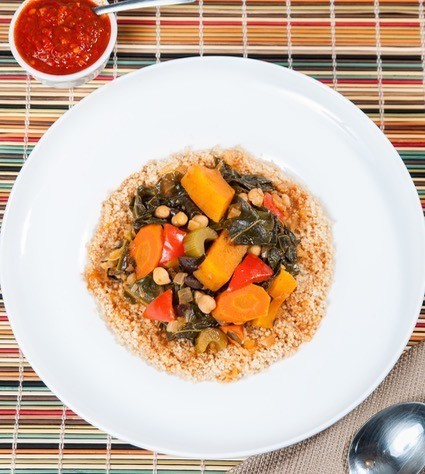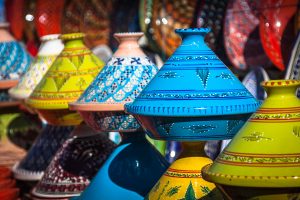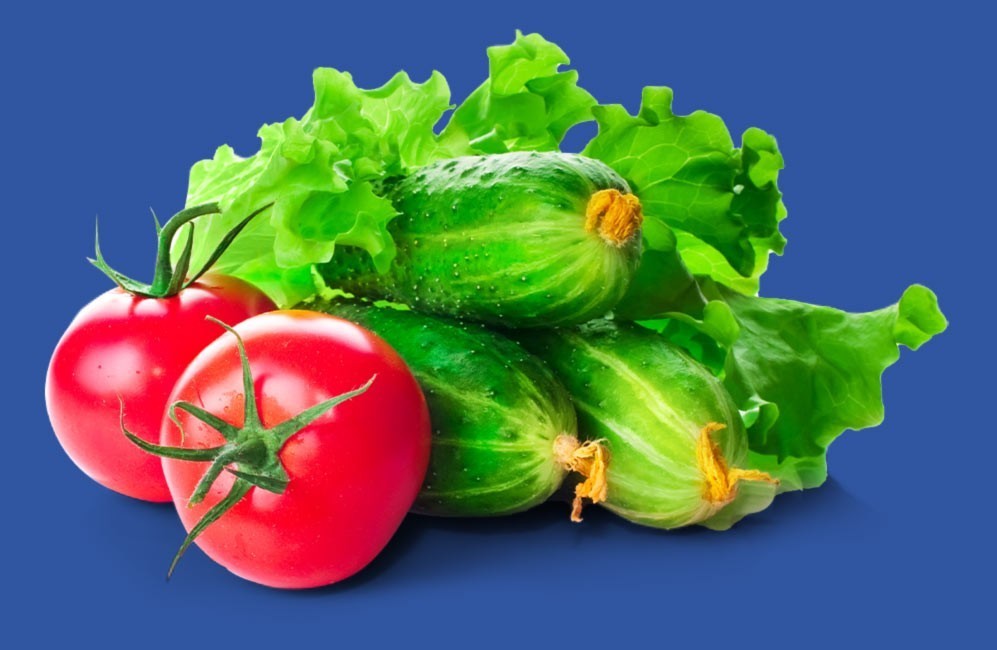Mediterranean comfort food like this aromatic Moroccan stew makes a cheering antidote to January’s short days and roller coaster weather.
In Morocco, dishes like this show the difference between using a combination of spices like cumin, paprika, cinnamon and ginger to create comforting warmth rather than the fiery heat of chile peppers. When local cooks shared their recipes, I was stunned by the amount of spices they called for. And the liberal amounts of onions, parsley, and cilantro they use, as well. Simmered together, they blend exquisitely, giving Moroccan cooking robust, complex flavor.

Tagines are an almost infinite variety of Moroccan stews. They are also the clay pot in which a tagine is made. Steam rises as these stews cook, hitting the convex sides of its cone-shaped top. The steam then condenses and falls back into the simmering food. This concentrates its flavors and keeps the dish succulent. I love using the tagines I hauled back from Morocco.

Tajines in the market Marrakesh Morocco Afrika
Happily, though, any heavy pot with a tight-fitting cover works almost as well, according to Paula Wolfert, the American doyenne of Moroccan cooking. In fact, concerned about chipping my clay tagines, I often use the enameled cast iron pot I also love for making soups, and the results are just fine.
This vegetarian tagine is a cozy combination of dark greens, bright carrots, winter squash, and chickpeas. I use big, tough collard leaves that become meaty and tender, taking care to remove their hard center vein along with their stems. Butternut squash is creamy and sweet, but I also use pumpkin-like calabaza, which brings more moisture. I cut it into big, chunky cubes so it holds together. Kabocha squash would be good, too.
Some canned chickpeas are soft and others are firm. I recommend using a brand with firmer beans so they hold their shape and do not go mushy, even if this means selecting one that costs more. After all, although collards provide a surprising three grams of protein per serving, chickpeas are this dish’s main protein source.
Olives are the surprise that makes this tagine special. Until I went to Morocco, I rarely used olives in cooked dishes. I also did not know that in addition to green and black, olives came in beige, mauve, purple and shades in between. Sampling them at the olive vendors found in every souk, I discovered that they could be velvety, grainy, tender, or tough-skinned. Brined or oil-cured is another choice. Here, the big, firm olives called Sicilian-style are ideal. Their salty tang enlivens contrasts perfectly with the tagine’s earthy spices.
Tagines, in Morocco, are eaten by breaking off a piece of crusty bread and, holding it between the thumb and first two fingers of your right hand, grabbing some of the stew to pop into your mouth. Pita bread is too doughy and it tears too easily. And learning this maneuver without dropping much of dinner in your lap takes practice. Instead, I like this particular tagine served over couscous.
Stews, including this tagine, improve when made ahead and reheated. So I make it to share but also just for myself, having portions of it over several days.
The Healthy Recipe: Collard Greens Tagine with Chickpeas and Olives






Where’s the recipe?
sorry – technical difficulties! It’s linked correctly now.